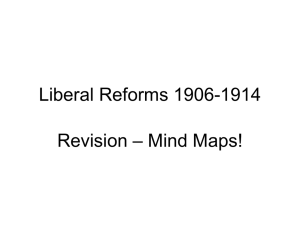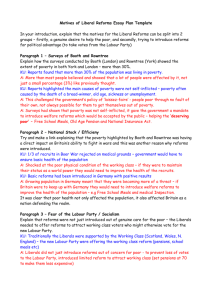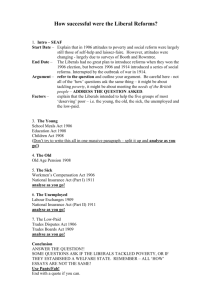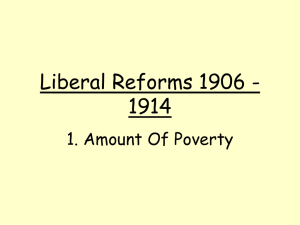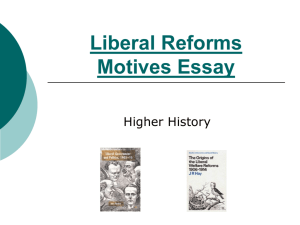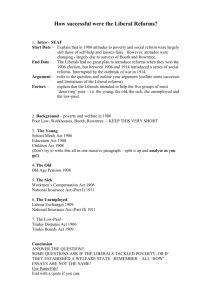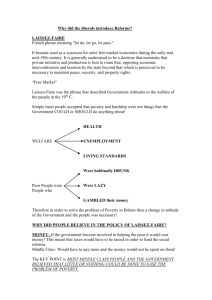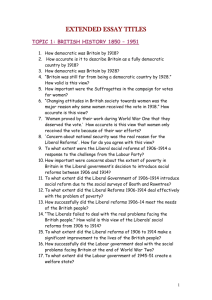Liberal Reforms Motives
advertisement
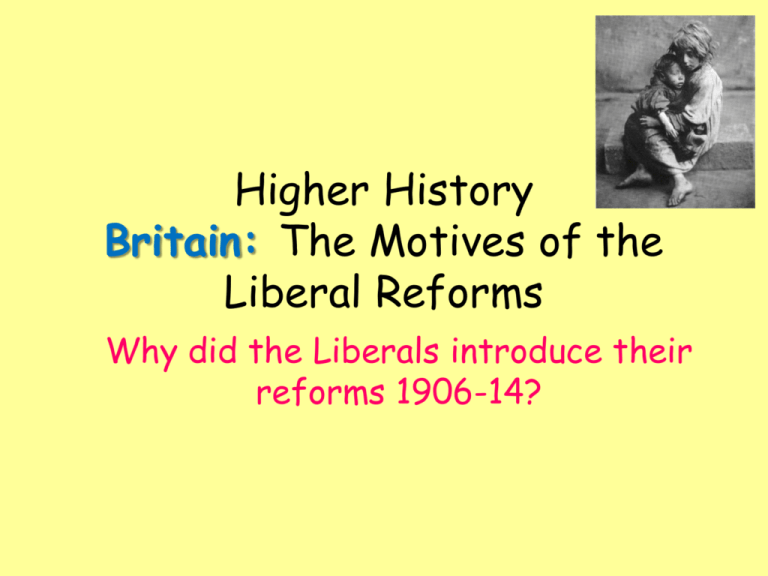
Higher History Britain: The Motives of the Liberal Reforms Why did the Liberals introduce their reforms 1906-14? We are learning to… Explain why the Liberals introduced a series of reforms between 1906 and 14 I can… Build up notes on the topic Plan a 20 mark essay Pass a 20 mark timed essay Background (for intro) • Prior to 1906, there was almost no help available for poor people in Britain • The liberals had always had a ‘laissez-faire’ style of government – not interfering in peoples’ lives • The only limited help available for those in poverty was the ‘Poor Law’ which was means tested • This usually resulted in people being put in a workhouse (poorhouse in Scotland) where conditions were horrendous – 90% of people refused this option • Charities such as Barnardos, the Salvation Army and the YMCA offered what help they could to people but demand was too great for them to help everyone • From 1906 the Liberal government introduced welfare reforms (changes in the law) to offer more help to the poor What were the MOTIVES for the Liberal Reforms 1906-1914? • When the Liberals were elected in 1906, there had been no mention of introducing social welfare reform in their manifesto. • So why did the Liberal Reforms like free school meals and pensions get introduced? • There were 5 factors/ motives for reform The arguments for the introduction of Liberal Reforms ‘The Factors’ 1. Surveys of Booth and Rowntree 2. Fears over National Security/ Efficiency 3. Fear of the Labour Party 4. ‘New Liberalism’ 5. Municipal Socialism 1. Booth & Rowntree - Knowledge • At the end of the 19th century two social surveys were published that not only shocked the British public but changed popular opinion on the causes of poverty. • Charles Booth was a London Businessman who carried out his survey in the East End of London and published his results in 1899 Life and Labour of the People of London • His book showed that 35% of London’s population lived in extreme poverty, that poverty was so bad that only the government could help and that if nothing was done, Britain was on the brink of a socialist Revolution • Seebohm Rowntree published his study of York to identify if the problem of poverty was as bad in the towns of Britain • He found that 30% of York’s population lived in poverty, that there was a ‘poverty line’ of the basic minimum amount a family needed to survive and that there were certain times that individuals were more likely to fall into poverty – most importantly old age Charles Booth • “The survey into London life and labour”. • Click on image to view video clip. Seebohm Rowntree • First York study (1899). • Click on image to view clip. Findings of the Surveys • Their findings agreed on some key points: • Up to 30% or almost 1/3rd of the population of the cities were living on or below poverty levels. • The conditions were such that people could not pull themselves out of poverty by their own actions alone. • Poverty was not self inflicted • Booth and Rowntree both identified the main causes of poverty as being illness, unemployment and age - both the very young and the old were at risk of poverty. Social Surveys: Analysis Analysis (basic) • This shows that politicians now had statistical evidence to which showed that no matter how hard people tried, they could not lift themselves out of poverty and the government would need to act to help them • In addition, the surveys helped promote the idea of a ‘deserving poor’ those who were trying to lift themselves out of poverty which was an important theme of the liberal reforms and started to break down old ideas that poor people were lazy, ignorant and squandered their money Social Surveys: Analysis Analysis (+) • However, it is important to remember that there were many people, MPs included, challenged the surveys and still believed that poverty was not widespread and that poor people wasted their money on alcohol and gambling which caused them to be poor • In addition, poverty in rural areas was ignored by the surveys as they focussed only on inner-city areas like London and York 2. Fears over National Security/ Efficiency • The Boer War (1899 - 1902) – National security • Britain became involved in a war in South Africa, which was part of the British Empire at the time • The government became alarmed when almost 25% of potential volunteers were rejected on the grounds of ill health • This figure was even higher when it came to the industrial cities like Manchester • This was greatly alarming as the British Army should have been able to protect the country against enemies far stronger than the Boers. Germany and National Efficiency • It was felt that countries like the USA and especially Germany were pulling ahead of Britain. • Liberal politicians like Winston Churchill and Lloyd George had visited Germany (Britain’s main rival) and were impressed by the effects on the nations health by the range of welfare benefits the German government had introduced – e.g. pensions and free school meals. • Germany had introduced reforms like pensions and school meals since the 1880s • Lloyd George warned after his visit that British young men could not compete with those in Bismarck’s Germany and that young unemployed men did not know where to find work in Britain National Security & Efficiency: Analysis Analysis (basic) • These concerns during the Boer War and over Germany were a definite motive for reform because if Britain did not have a fit and healthy workforce then they would not be able to compete in future wars such as the one looming with Germany or retain their status as ‘Great Power’ • The very earliest reforms in 1906/7 (free school meals and medical inspections) are generally considered a direct result of the fears over national security and efficiency Analysis (+) • However many historians have challenged this view that politicians had any genuine concern for the welfare of the poor and instead wanted to pass reforms for political advantage – such as Churchill making a name for himself or the liberal party wanting to gain working class votes over Labour 3. • • • • Fear of Labour Party/Political Advantage The Labour Party was newly established in 1900 and it was winning public support for its campaigns for social welfare policies, such as old age pensions and unemployment benefits. The ruling Liberal Party recognised the threat this new party posed to its traditional support in many working class areas. They needed to offer something similar to woo the working class male voters The Labour party already had the support of working males through it’s affiliation with the Labour party and this was a threat to the ruling Liberal party Fear of Labour/ Political Advantage: Analysis Analysis (basic) • To counter the threat from the socialist and Labour movement, the Liberals realised that they had to introduce social reforms or risk losing political support from the working classes so they tried to ‘buy off’ voters with smaller reforms to avoid bigger ones e.g. offered pensions but raised the age limit to 70 years old. Analysis (+) • However many historians have pointed out that the Liberals cannot have been truly worried by the Labour promises otherwise they would have matched or bettered the Labour party by offering pensions earlier Labour party were still very small in 1906 (29 seats) so probably did not pose a threat in terms of winning an electoral majority 4. New Liberalism • Old Liberalism meant Laissez – faire; poverty as the problem of the individual and minimal state intervention • A new type of Liberalism had emerged by 1906, and it was this ‘New Liberalism' which provided the inspiration for reform. • New Liberals, such as Lloyd George, Winston Churchill and Herbert Asquith, argued that there were circumstances in which it was right for the state to intervene in people's lives. • They represented poorer areas – e.g. Lloyd George in Wales and Winston Churchill in Dundee. New Liberalism - Analysis • Analysis (basic) • This shows that ‘New Liberalism’ was becoming more influential within the ruling party due to the more modern and interventionist ideas of new Liberals like Churchhill and Lloyd George and the party was reforming from within and starting to believe that reform was necessary to help those in need Analysis (+) • However, historians have pointed out that the new Liberals were still vastly outnumbered by ‘old’ laissezfaire Liberals and it was only when ‘old Liberal’ Campbell Bannerman died in 1908 that the new Liberals were able to introduce their interventionist ideas 5. Municipal Socialism • During the later 1800s the public had enjoyed the intervention when Local authorities had been taxing people and using the money to improve local areas • This showed people a basic socialist idea in practice – redistributing wealth – and it worked! • It paved the way for the Liberals to introduce reforms which would obviously cost more money e.g. pensions Birmingham – an example of municipal socialism • In 1873 Liberal Joseph Chamberlain became mayor of Birmingham and introduced many reforms there • Birmingham's water supply was polluted and only supplied 3 days a week; he bought the waterworks and ran it for the good of the people • He did the same with the gasworks • He cleared many slum houses • One report said he left Birmingham ‘parked, paved, gas and watered and improved’ Public parks were another example of municipal socialism; bought by local councils to provide fresh air and recreation for people i.e. in Glasgow city 5. Municipal Socialism - analysis • Analysis (basic) • Improvements to towns and cities done at local level using taxes had shown people that municipal socialism worked; everyone was taxed dependent on income but the positive end result outweighed the taxation • This local socialism paved the way for similar reforms at national level and set a trend for social reform that the Liberals picked up on and continued Analysis (+) • However, we must remember that the local model was not able to change the minds of everybody in terms of government intervention. There remained huge opposition in Britain to the idea of taxing the wealthy more to provide for the poor – particularly from the upper classes and middle classes who resented losing out financially to provide for the needy Main Liberal Reforms • 1906 Free School Meals – 14 million per week being issued by 1914. • 1907 Medical Inspections Act – medical inspections given at school • 1908 Old Age Pensions – 25p per week for those 70+ (1/4 average wage). • 1911 National Insurance I – sickness benefit for poorer workers – e.g. paid for doctor and medicine. • 1911 National Insurance II – gave unemployment insurance to half a million poorly paid workers or those in seasonal employment. Consolidation • A good idea when you have taken all your notes for a topic is to create a condensed revision guide for the essay • This might be a mind map, picture map, bullet points etc. but should fit on one page • Do this for homework Essay Questions • The Liberals motives is an example of an isolated factor essay – this means the SQA will ask you whether women got the vote because of a specific factor (one of the 5 we cover) • You must talk about the factor in the question BUT you do not need to agree it is the most important • Examples • How important were fears over national security and efficiency in the Liberal government’s decision to introduce social reforms, 1906-1914? • How important was fear of the labour party/ political advantage in the Liberal government’s decision to introduce social reforms, 1906-1914? • How important was the rise of new liberalism in the Liberal government’s decision to introduce social reforms, 1906-1914? Introduction – 3 step plan • Background (2/3 sentences – describe Britain’s help/ lack of help for poor before reform) Before the Liberal Reforms… • Factors (what are the factors in the essay?) There were many motives for the liberal reforms such as… (1 in question 1st) (a list is fine) • Argument (what will you be arguing is most important?) It can be argued that the most important factor was …because… Conclusion – 4 step plan • In conclusion, there were many reasons why the Liberals introduced reforms. • On the one hand… (you should take one key factor here and explain why it was important) • On the other hand… (now you should do the same with another key factor to balance your argument) • Overall, the most important factor was… (keep your strongest until last, backing up why it is so important and it should be clear why it outweighs the other factors) Example question – specimen paper How important were the social surveys of Booth and Rowntree in the Liberal government’s decision to introduce social reforms, 1906-1914? 20 marks Practice essay due Thurs 23/4. Liberal Motives – timed essay How important was the idea of municipal socialism in the Liberal government’s decision to introduce social reforms, 1906-1914? 20 marks Evaluation • A good way to approach trying to get the final 4 marks for evaluation is to take your factors (5 in this case) and rank them from most important to least important • Try to come up with a reason Why each is in that place (not why it is important but why it is more or less important) • A priority diagram can be a good technique to use – try to relate every factor back to your most important Factor 1 Factor 2 Factor 3 Factor 4 Factor 4 Evaluation E1 and E2 - 2 marks can be gained from making evaluative comments which relate to individual factors Example – Upon evaluation, ______ was the most/least important factor in the introductions of reforms because... NB – You must be saying something new in your evaluation, not repeating your analysis or doing ‘mini conclusions’ Evaluation + E+ - up to 4 marks can be gained from making evaluative comments which show the relative importance between factors (i.e. you compare two) Example – Upon evaluation, the fears of national security were more important than ______ in the Nazis staying in power because... NB – You must be saying something new in your evaluation, not repeating your analysis or doing ‘mini conclusions’ Remember analysis is really tricky and many candidates get 0/4 but still get an A!

